
Art Therapy
Art Therapy: A Space to Explore, Create, and Heal
Art therapy offers a gentle way to explore your inner world when words don’t always feel like enough. The creative process can be spontaneous and intuitive, helping you connect with Parts of yourself that may not have had a voice before. Through the act of creating, you can begin to see your experiences from new perspectives, express what feels hard to say, and discover a deeper sense of understanding and compassion for yourself.
Art therapy helps you look beneath the surface by transforming thoughts and feelings into visual expression. It encourages awareness, self-acceptance, and emotional balance, while providing a contained, safe space to process whatever emerges. Whether expressed through art or conversation, therapy should always offer a supportive and nonjudgmental environment for self-exploration.
In art therapy, you don’t need to be “good at art.” You don’t even need to think of yourself as creative. The focus isn’t on making something beautiful — it’s about allowing whatever wants to emerge to take shape. Commonly throughout life, people lose their connection to the creativity that exists within themselves as they age. Art therapy offers a place to reconnect to these parts of yourself. Sometimes that looks like color, texture, or movement on a page. Sometimes it’s about noticing what shows up and what it feels like to make it. The process itself can offer grounding, insight, and relief.
Art therapy sessions are led by master’s-level, licensed art therapists who combine clinical knowledge with creative practice. Their training allows them to guide you through a process that is both psychologically informed and personally meaningful.
Art therapy is an invitation — to slow down, to notice, to express, and to reconnect with your innate
creativity. You don’t have to have the right words or the right skills. Just a willingness to be curious and
open to what unfolds.
Art is rooted in our history as humans, from the stone age, we have always used creativity to develop tools such as bowls, tell stories, and use paint to connect to our pasts.
Even if it feels unfamiliar at first, creative expression can help you:
Recognize and validate emotional responses while connecting the mind and body
Explore and integrate conflicting feelings
Build confidence through trying new ways of expressing yourself
Understand and regulate difficult emotions in healthier ways
Deepen insight, compassion, and personal growth
What is Art Therapy?
-

Art Therapy is....
- Facilitated by a master’s-level, licensed art therapist
- Focused on process and presence, not perfection
- A compassionate way to engage with your emotions and experiences
- Open to people of all ages, backgrounds, and abilities
-

Art Therapy is not...
- About making “good” or “beautiful” art
- A class in art techniques
- Just for children
- Only for artists or creative people
How can Art Therapy help?
Many people turn to art therapy when words alone aren’t enough — especially when working through trauma, stress, grief, or long-held emotional patterns. Research shows that traumatic memories are often stored in areas of the brain that respond to imagery rather than language — making art a powerful tool for healing. Through creative work, art therapy can:
Support the recall and processing of memories that may be hard to access verbally
Integrate both emotional and cognitive experiences by engaging both hemispheres of the brain
Create safe distance from distressing material, making it more manageable to explore
Facilitate healing for those coping with complex or ongoing trauma
“Art enables us to find ourselves and lose ourselves at the same time.”
~ Thomas Merton
Start exploring how embracing creativity can help you heal today.
Art Therapist
-

Lacey Davis LCPC LCPAT
Adult Art Therapist






